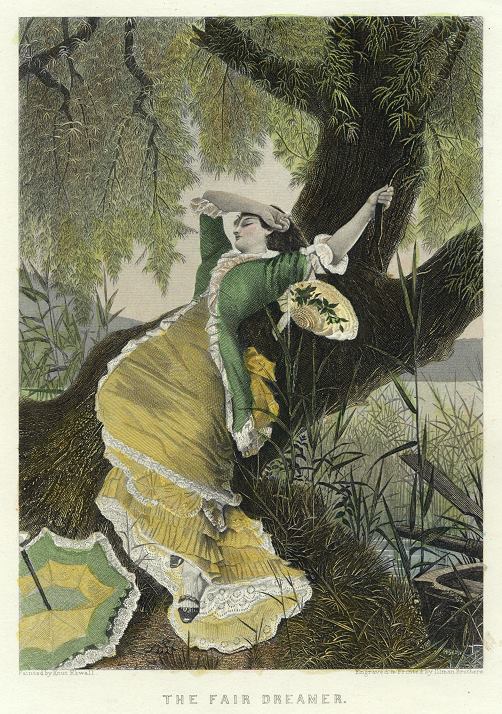Both Christina Rossetti’s poem Goblin Market and the Illman Brothers’ etching The Fair Dreamer engage in a long artistic tradition of placing females in idyllic settings. In both texts, nature is associated with sexual desire and seduction.
While The Fair Dreamer may appear like an innocent portrait of a sleeping female figure, a closer look suggests salacious undertones. The bend of the tree on which the woman rests draws attention to the sensuous S-curve of her body. Although her body remains covered, the shadows and highlights on her skirts create the impression of stretched fabric and consequently suggest that her knees are spread apart provocatively. Reinforcing this sexual position, the tension in the clenched hand that tightly grips the tree branch suggests the ecstasy of climaxing, rather than the relaxation of sleeping. The propriety signified by her parasol and hat is cast carelessly aside as she basks in the wood by a brook on a lush summer day.
In a similar way, Goblin Market also posits nature as the site of sexual desire. For example, the poem repeatedly locates the goblin men selling their fruit in a “glen” (474, 477, 488) by a “brook” (474, 479, 488). This emphasis on sexual threat, represented by the goblin men, within a natural setting is emphasized by the parenthetical line “(Men sell not such in any town)” (488), “such” referring to “fruits” two lines previously. The populated “town” is free of corrupting fruit, but the “haunted glen” (488) is fraught with temptation. Like the etching, which suggests the fertility of summer by depicting a thick canopy of green leaves and tall reeds, the poem sets the action in “summer weather” (480). The “warm” wind suggests the heat of desire and passion (474).
Just as the curves of the woman’s figure are mirrored in the contour of the tree trunk in The Fair Dreamer, Goblin Market frequently compares the sisters to trees. For example, a simile likens Laura’s “gleaming neck” to a “moonlit poplar branch” (475), and later in the poem her “fallen” nature is compared to “a wind-uprooted tree” (487). Lizzie, too, is compared to a tree to emphasize her simultaneous strength and vulnerability:
“Like a fruit-crowned orange-tree
White with blossoms honey-sweet
Sore beset by wasp and bee” (484).
The stingers associated with “wasp and bee” here suggest a phallic metaphor, as does the earlier description of the “Their hungry thirsty roots” (474). In the poem, the antecedent of the pronoun “they” is ambiguous, referring to either “goblin men” or “fruits”; the phallic image of “roots” is paralleled in the skinny tree branch that the woman grips in The Fair Dreamer.
As these two texts demonstrate, sexual desire is often juxtaposed with nature because of its fertility, seclusion, and phallic associations. Yet the texts muddy the exact relationship between nature and women: are women one with nature, or does nature pose a particular threat to them?

I’m curious about the question you pose at the end of your post: I think these two texts offer different answers. While Rossetti’s poem does idealize nature, ultimately it is threatening. In seeking out the goblin men, Laura not only ventures further into nature but also cuts herself away from Lizzie and the rest of her community, which provide safety from the sinister aspects of nature. Nature cannot be navigated by women alone; rather, they must support each other against its temptation. In “The Fair Dreamer,” however, nature itself does not seem to threaten the woman. In this case, it is the intrusion of society (represented by us, as the audience looking at the painting) into this scene that is dubious.
I wonder if the connection you made between female sexuality and nature have anything to do with blame. I say this because perhaps this commonly used connection in Victorian art and literature stems from the attitude that women’s bodies are naturally sensual and tempting, and therefore shameful. This brings me to think of the sexist dress codes at schools being brought to light in current news. These codes teach girls that their bodies are naturally shameful and should be covered up as to not be “dangerous” and a “distraction” to their male peers.
So to answer your last question, perhaps writers and artists are not saying nature is a danger to women, but a danger to others. This would make the blame fall on the shoulders of women.